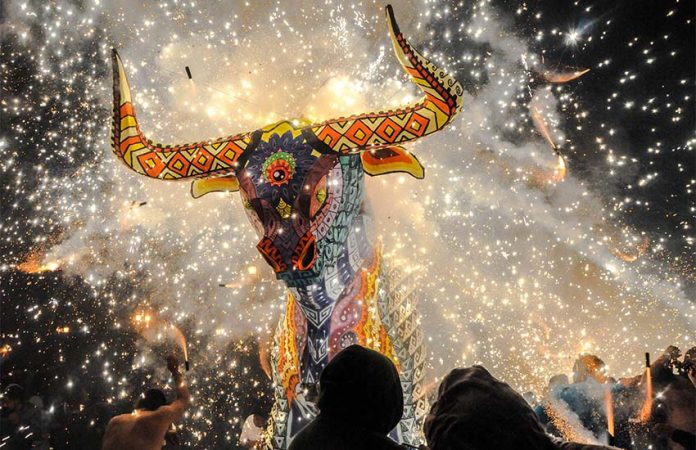The opening of the 35th International Pyrotechnics Festival brightened the Saturday night sky above Tultepec, México state — Mexico’s fireworks capital.
The event, which lasts through March 17, features rock concerts, artisanal food, folkloric ballet, a battle of the bands contest, a concert by local schoolchildren and much more.

Opening night was a hit with its castillo de torre (tower castle) contest. With thousands in attendance, fireworks companies demonstrated their talents with colossal, towering structures adorned with all kinds of fireworks.
The pyrotechnics structures are as much about creativity as they are about firepower. While some are simply made into geometric shapes, some are made to look like recognizable figures — such as Jesus on the cross, San Juan de Dios (St. John of God, considered the patron saint of fireworks artisans in the region) and Texcocan poet-king Nezahualcoyotl — or iconic imagery such as the Mexica calendar.
The castillos are judged on artistic presentation, colors, creativity, degree of difficulty and the quality of the fireworks — as well as audience reactions.
Other popular pyrotechnic events still to come during this year’s two-week fair include the popular March 8 parade of the toritos — fireworks connected to bull-shaped structures — a musical fireworks contest on March 9 and an international musical fireworks contest on March 16. Among the countries taking part in the latter contest are Puerto Rico, the United Kingdom and El Salvador.
For a schedule of the events for the remainder of this year’s festival (in Spanish), go here.
The fair has its roots in 19th-century torito parades sponsored by Tultepec fireworks guilds and held on St. John of God’s feast day, March 8. The event now serves to promote Mexico’s traditional fireworks industry, which produces nearly 6 billion pesos (US $354 million) of recreational explosives annually.
Tultepec produces roughly three-quarters of the nation’s fireworks and about 40,000 local families — nearly 60% of the municipality’s population — work in the production and distribution of fireworks.
There are more than 300 workshops here. Although specialized training has made the industry safer, accidents remain a danger.
In 2018, 24 people were killed and dozens were injured by a series of explosions in the municipality. Twenty-two of the dead were rescue personnel killed by subsequent explosions after approaching the scene following the initial explosion.
Critics say gunpowder and other materials are too often stored in homes and bodegas illegally and under unsafe conditions. A December 2016 blast in the Tultepec fireworks market killed 42 people, the worst incident in the city’s history and one that made international news.
The same market was previously destroyed in a 1988 fire, after which local authorities banned the manufacturing and wholesaling of fireworks within the city limits. The ban was lifted a year later, and the International Pyrotechnic Festival was inaugurated to compensate for the loss of revenues.
With reporting from La Jornada and El Universal
